Analyzing the Price of Mobility: Desktops vs. Laptops
by Jarred Walton on September 7, 2013 5:55 PM ESTGPU/Graphics Performance Discussion
The other area of performance we want to look at is the GPU/graphics side of the equation. Where CPU performance has really started to level off – only overclocked CPUs or hex-core/octal-core options really hold serious performance advantages over the fastest mobile CPUs, and then only in heavily threaded workloads – the same can’t be said of graphics chips. Part of the problem is power requirements, as high-end desktop GPUs can draw up to 300W under load, which is three times what the most powerful mobile GPUs are rated to draw. The form factor also comes into play, but really I think power is the far more limiting factor.
Of course, there's a big difference in terms of what we do with CPUs vs. GPUs and how we do it. Most CPU-intensive tasks don't easily scale beyond a certain level of multi-threadedness, and some tasks really don't scale at all. The easiest example is anything that requires user input: no matter how fast your CPU gets, Word isn't going to type any faster than your fingers can go – or if you use speech recognition, any faster than you can dictate. Graphics on the other hand is practically infinitely parallel, where we can break things down into smaller and smaller pieces of a screen being rendered/computed by individual GPU cores. Many tasks on the CPU don't scale beyond four or maybe eight cores, but graphics is easy to scale to thousands of cores and beyond. So GPUs can get as large/fast as we can conceivably make them and there are still ways to tap into that performance potential; that's why modern systems typically have GPUs that consume two to ten times as much power as the CPU(s).
Let’s again put together some comparisons, only this time we’re a bit more limited in what we’ve tested with modern GPUs – on our desktop tests, we only have an overclocked GTX 680 and a GTX 780 with all of our gaming results, while on mobile we have a few additional reference points. I’ve also added Bioshock Infinite and Sleeping Dogs numbers for additional GPUs from our GPU 2013 test suite, but that’s only two of the seven titles we’re testing on laptops. We’re now looking at entire systems, but the GPUs are the primary factor in gaming performance. Also note that our reference point (1080p Max Detail, usually with anti-aliasing) is far more demanding than what most gamers actually require, but in terms of a performance discussion at least we can get an idea of where mobile GPUs stand.
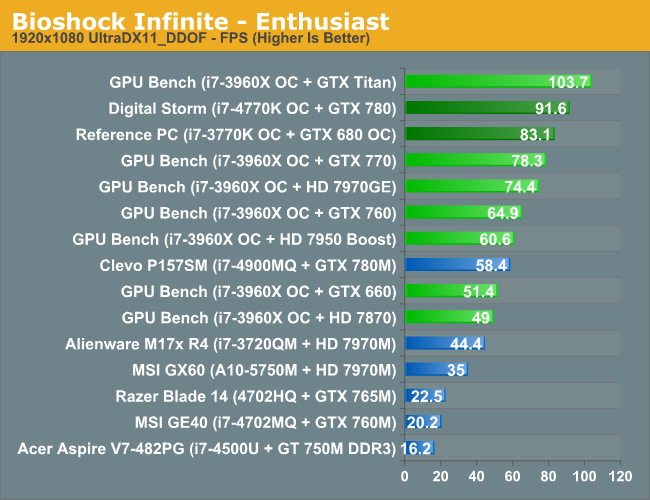
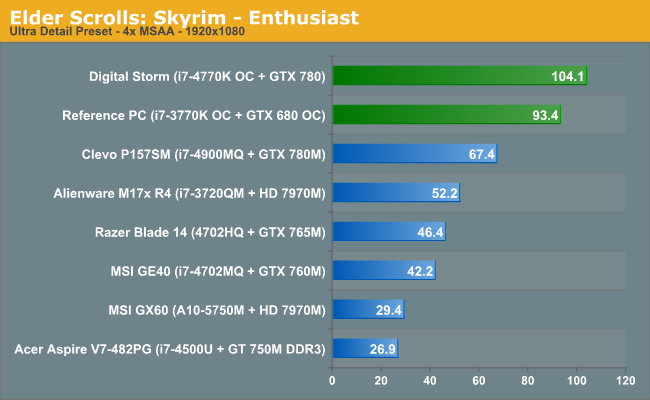
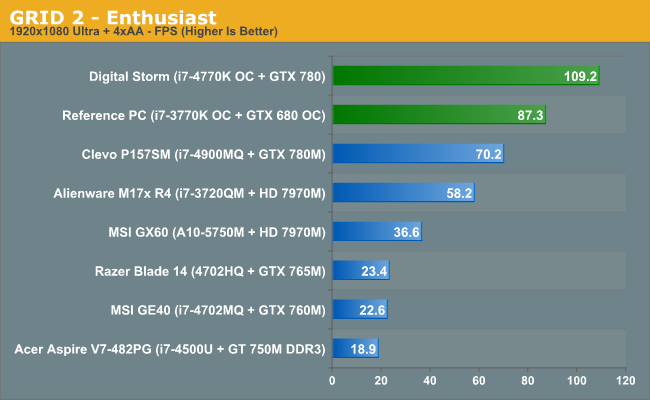


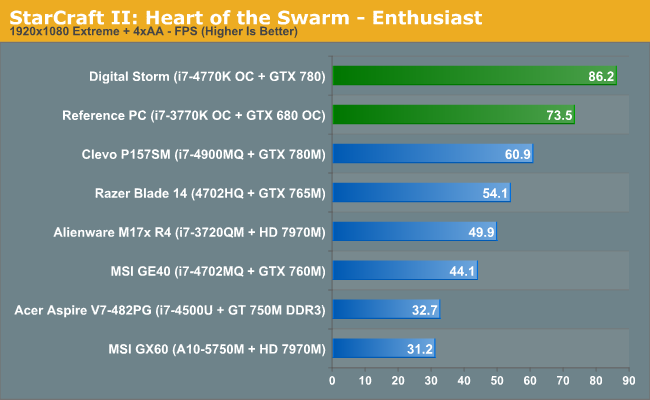
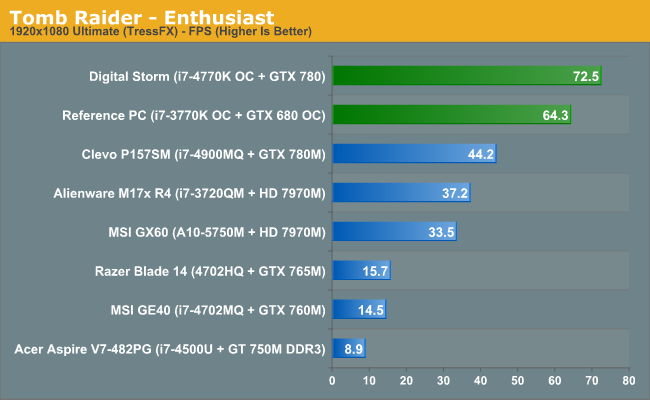
As far as replacing gaming desktop performance with a notebook is concerned, we’re nowhere near close to accomplishing this task. CPU requirements for the vast majority of users have reached a plateau during the past five or so years, but for graphics (games) we can still use pretty much all the horsepower available. The fastest mobile GPU we have right now, the GeForce GTX 780M, ends up delivering performance that falls roughly half way between the GTX 660 and GTX 760, or if we look at the Digital Storm system Dustin tested, it offers 60-70% of the performance of that desktop. Moving down to the lower performance mobile GTX parts like the GTX 765M, we haven’t tested any desktop GPUs in recent history that are anywhere near that slow – even the GTX 660 tends to be more than twice as fast as the GTX 765M and the GTX 560 Ti is still 50% faster. Drop one level further to the GT 750M (DDR3) and performance is about 60-80% of the GTX 765M! It’s not that you can’t game on a GT 750M or GTX 765M, but you’ll definitely need to drop the details down from max and turn off anti-aliasing. Finally, no matter what you do with a notebook, you’re not going to match the performance of the fastest desktop GPUs – the GTX Titan nearly doubles the performance of the GTX 780M, and even SLI GTX 780M isn’t likely to beat a Titan on a consistent basis.
Looking at pricing is also illuminating. Most notebook vendors charge around $650 (give or take) for a second GeForce 780M on the Clevo P370SM, compared to the desktop GTX 760 (which has slightly higher performance) that can be purchased for $250. Meanwhile, the desktop GTX 780M sells for the same $650 price as the GTX 780 while offering only 60-70% of the performance you get from the desktop GPU; the GTX 680 and GTX 770 have the same number of CUDA cores (1536) and go for $400, delivering superior performance at a substantially lower cost. The pattern continues as we move down the product stack; the slowest desktop Kepler, the GeForce GT 630, is a $65 card that has slightly higher clocks than the GT 750M, never mind the GT 730M and GT 740M, but the GT 730M is typically a $70 upgrade on a notebook. The GTX 765M has the same number of cores as the $130 GTX 650 Ti but with lower clocks; it reputedly sells for close to the same price to laptop OEMs as the desktop GTX 760 we mentioned as a performance equivalent of the GTX 780M.
Of course, where you can easily add a GPU to most desktops, with laptops you’re basically stuck with whatever you initially purchase. I noted in the Gaming Laptop Guide last month that the lowest price I could find for a notebook with a GTX 780M ends up around $1750 (including the OS with a 1TB HDD). For equivalent performance (more or less), we can take the desktop we listed above and add a GTX 760 GPU, with a slight PSU upgrade as well just to be safe. Here’s what we end up with:
| Mainstream Gaming Desktop PC | ||
| Component | Description | Price |
| CPU | Intel Core i5-4670 (Quad-core, 3.4-3.8GHz, 6MB L3, 22nm, 84W) | $200 |
| Motherboard | ASRock Z87 Pro3 LGA-1150 | $115 |
| GPU | GeForce GTX 760 | $250 |
| Memory | 2x4GB DDR3-1600 CL9 1.5V RAM | $65 |
| Storage | Seagate 1TB 7200RPM HDD | $70 |
| Optical Drive | SATA DVDRW (Lite-On) | $18 |
| Case | Antec Three Hundred | $60 |
| Power Supply | Rosewill Green RG530-S12 530W 80 Plus Bronze | $55 |
| Operating System | Windows 8 64-bit (OEM) | $100 |
| Total | $933 | |
Opting for a gaming notebook thus carries a hefty price premium, nearly doubling the price of a similar performance desktop. Yes, the notebook still gives you a battery, display, keyboard, touchpad, and speakers as part of the package, but if you already have those for an existing desktop they’re not really necessary. The price premium for high-end gaming notebooks has certainly come down from the 2x-3x we used to see (though you can still get to that range with SLI notebooks), but we’re nowhere near parity like we are on the CPU side of things. As an alternative, desktop GPUs are also able to hit much higher performance levels at a similar cost to a high-end gaming notebook.
Given the various options, many people have concluded that it’s far better to have a decent gaming desktop like the one above and then to spend another $500-$1000 on a good laptop for when you need to go mobile. That’s generally my recommendation as well – for all the gaming notebooks I’ve reviewed over the years, I still turn to my desktop system 95% of the time when I’m looking to play a game. On the other hand, not everyone wants to worry about having two computers and syncing data between them, and there are also space limitations to consider. Finding a spot for a 10 pound gaming notebook in a college dorm is easy enough; finding space for a gaming desktop with display, speakers, keyboard, and mouse can be a bit more difficult. And if you’re regularly on the road and want to take your games with you, you’ll need the laptop regardless.
There’s no right answer for how to do things, of course. Some people love gaming notebooks and others don’t see the point. But while you can certainly make a case for typical notebooks/laptops now being close to price parity with similar performance desktops, once you add gaming into the mix you’ll need to pay the mobility piper his due.










110 Comments
View All Comments
JarredWalton - Monday, September 9, 2013 - link
There's also the screen size issue. For handheld tablet use, a 7" screen is fine. Sitting on a desk with a keyboard, however, 7" can be painfully small for anyone over 30 or with moderate vision to read. Even 10" tablets may not work for everyone, but at least I can make a good go at it.rburnham - Monday, September 9, 2013 - link
It really does come down to lifestyle. A buddy of mine is on the go a lot, so he invested in a good Alienware gaming laptop. It's big, it's fast and it can double as a nice workstation too.On the flip side, I currently do not travel at all, so I have a desktop workstation and desktop gaming PC. However, I plan to move to a new area in the near future, where I will be traveling on the weekends. I will keep the gaming desktop, but the workstation will be replaced with a mid-range gaming laptop, which will double as a 1080p workstation while at home.
I just love that we have these options. It's a great time to be a computer user.
Sadrak85 - Monday, September 9, 2013 - link
The facts here actually support a slightly different conclusion, although noted to be out of the scope of the article; for "basic" computing needs such as web-browsing, you don't need massive performance, and even those laptops are more than required. Mobile is the answer. Mobile can handle email, web, basic text-editing, some photo, and presentations. Thus, the ideal setup is your own preferred mobile device and a desktop for 1)ergonomics, 2)value, 3)speed, 4)reliability. Forget the laptop entirely! It's the "Utility Van" of the modern era. Niche cases, like hardcore gamers on the go, or someone who needs just enough power on the move to whine about a tablet, but not enough to remote-desktop to a more powerful machine. The only reason there is still a laptop in my home is because it's a relic of my wife's college days, and it's nice to play Minecraft in the same room as her (she gets the 3240x1920 display when we play together because I'm a gentleman).JarredWalton - Monday, September 9, 2013 - link
I mentioned tablets in the introduction, and for most people that need to type anything I still feel laptops are far superior to tablets. Others will disagree with that, and that's fine, but I have typed a fair amount on my two 10" tablets over the past two years, and I don't like it at all. Adding a keyboard could fix some of the issues, but then I have something larger to carry around and a 13.3" laptop (or 14" laptop) is still going to provide a much better keyboard experience for anyone that doesn't have petite hands.Sadrak85 - Tuesday, September 10, 2013 - link
Yeah, but an ergonomic desktop keyboard is better still; tech journalists who travel need decent laptops because they're writing in hotel rooms, etc., and maybe paperback novelists need the inspiration of writing in a cabin in the woods, but when I update my website, I do it in front of my desktop, in my home office, where a laptop would cramp my style.max1001 - Monday, September 9, 2013 - link
Gamers are what keep the desktop market alive. You can keep playing games on release date at max setting as long you keep upgrading your GPU now and then. I usually upgrade mine once a year and sell the old one on Ebay. The whole system get a refresh every 3 yrs or so.Laptop on the other hand are totally different story. My XPS 17 with 650m going to be useless in a year for gaming and it's not even worth selling it back out on ebay.
Sadrak85 - Tuesday, September 10, 2013 - link
Don't forget cheapskates (the only reason I overclock is so I don't have to buy the next model up) and people who own comfortable chairs and ergonomic keyboards.hoboville - Monday, September 9, 2013 - link
One important factor that cannot be expressed enough with regards to laptops--especially since you mentioned college--laptops get stolen a lot. You'd be hard pressed to find the same to be true with a desktop PC. And if you're a gamer with a $2000 laptop...not fun to contemplate.I refurbish and repair computers for a living, and people break laptops all the time (can't tell you how many times people have spilled beverages on them). Repairing them is rarely an option, if the customer has cracked the screen or messed up the keyboard and it's not under warranty...their options are very limited.
There's hidden costs to mobility and all-in-one solutions, performance is just one aspect. Besides, when was the last time you dropped your desktop PC accidentally?
vpk24_astro - Monday, September 9, 2013 - link
It'd be really interesting to see how far we are from discarding laptops entirely in favor of tablets. The thermal constraints - the only ones set in stone, should be the only limiting factor in the long run. Fortunately, the thermal envelope that laptops have to run in is very comparable to what tablets have to play with (factor of 2X or so in heat generated). How many generations before we see tablets as powerful as today's laptops? Are there any variants of desktop linux that have been ported to a tablet? Can I plug a keyboard, mouse, HDD and monitor into a tablet all at once?Selbatrim - Monday, September 9, 2013 - link
This is pretty much the same argument. You wonder when a tablet will be better than the CURRENT laptops but by then the laptop has progressed further and you still get more for less.The question seems to be when will the form factor no longer represent any impact on price or performance? For the mainstream this may perhaps happen in the next 10-15 years, but for the enthusiast it will take so long it is not really possible to contemplate.
Again, I just looked at this in a fleet refresh and the approximate priceratios we came up with was this:
1 tablet(full x64 specs here, not arm etc) for the price of 2 laptops or 4 desktops. Will this ratio change? Perhaps. But if you are looking at value for money the foreseeable future is desktop over laptop over tablet.